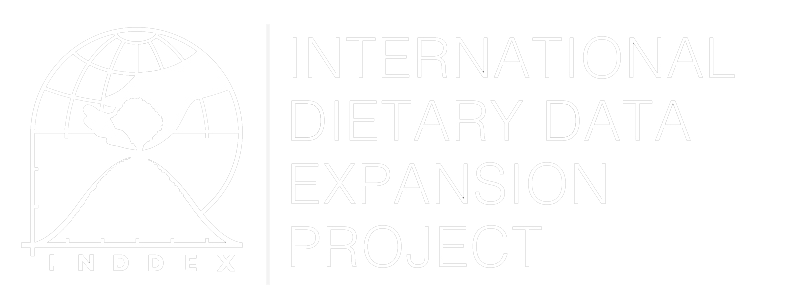Total Individual Energy Intake kcal/day
Overview
Total individual energy intake quantifies calorie consumption. Prolonged insufficient energy intake results in undernutrition and impaired growth, development, and functioning, and as a result many developing countries still suffer from high rates of underweight among adolescents and adults, and stunting and/or wasting among young children (Muller & Krawinkel, 2005). This is the only indicator included in the Data4Diets platform that strictly measures caloric intake at an individual level; other indicators that measure caloric availability at the household or national level are household average dietary energy acquisition or consumption and dietary energy supply. Examples of other indicators that use individual data to quantify nutrient intake include total individual micronutrient intake, which is measured in absolute terms, as well as the Mean Adequacy Ratio (MAR), which uses a scaled system to measure the adequacy of individuals' nutrient intake.
Method of Construction
To construct this indicator, an individual's intake must be recorded through a 24-hour Dietary Recall or Weighed Food Record. Population mean consumption can be estimated with a single survey, but the survey must be repeated on at least a subsample of the survey population for two non-consecutive days of intake to estimate "usual intake" (Institute of Medicine, 2000).
When repeated measurements are available for at least a subsample of individuals, the "probability approach", which accounts for day-to-day variability of food intakes at the individual level, allows to calculate the individual probability of inadequate intake for each nutrient, and a mean probability of adequacy (MPA) over a range of micronutrients. The final sample in the dietary survey should be representative of all days of the week.
A Food Frequency Questionnaire (FFQ) could also be used but would provide a less accurate estimate. A contextually relevant Food Composition Table (FCT) is used to determine the energy content in each food item consumed by the individual, and the caloric value of all food items is summed to calculate a daily total. For further information, please refer to Chapter 3 of this Food and Agriculture Organization (FAO) Food and Nutrition paper on calculating the energy content of foods (FAO, 2003).
Uses
This indicator is used to assess the most basic element of dietary quality: intake of sufficient calories. It can provide information on the risk of both over- and undernutrition, particularly for vulnerable population subgroups, such as pregnant and lactating women, and for understanding the allocation of food resources within a household. However, this indicator does not provide information on the makeup of calories consumed, which has serious health implications. Indicators such as total individual macronutrient intake or total individual micronutrient intake are more appropriate for assessing specific nutrient components of the diet.
Strengths and Weaknesses
One strength of this indicator is that it can be paired with findings on individual health outcomes or demographic information, such as religion, age, sex, education, or any other characteristics of interest (Ferro-Luzzi, 2002). One challenge is that dietary intake data are fairly time-consuming to collect, even though the resulting data offer huge potential payoffs in terms of the types and number of indicators that can be generated. Additionally, consumption of a sufficient number of calories is not an indicator of diet quality, as the source of the calories also affects nutritional outcomes nor does it say anything about micronutrient intake. Other indicators such as MAR or probability of inadequacy may be more appropriate for using individual nutrient intake data to provide a picture of the nutritional adequacy of the diet as a whole, as they are calculated across several nutrients.
Data Source
The intake data required for this indicator can be obtained through 24-hour Dietary Recall surveys, weighed food records, or FFQ (even if less accurate). The Food and Agriculture Organization and World Health Organization's Global Individual Food Consumption Data Tool (FAO/WHO GIFT) is a source for quantitative individual-level dietary data. The FAO/WHO GIFT aims to make publicly available existing quantitative individual food consumption data from countries all over the world.
National or regional FCTs should be used to identify the nutrient contents of the foods and can be found at FAO's International Network of Food Data Systems (INFOODS) or the Agricultural and Food Systems Initiative World Nutrient Databases for Dietary Studies (WNDDS). In addition, Food Balance Sheet (FBS) data could be used to calculate a similar indicator, such as dietary energy supply. Alternatively, Household Consumption and Expenditure Survey (HCES) data could be used to calculate household average dietary energy acquisition or consumption.
Links to Guidelines
Links to Illustrative Analyses
- Cohen et al., (1994). "Effects of age of introduction of complementary foods on infant breast milk intake, total energy intake, and growth: a randomised intervention study in Honduras."
- Schoeller, (2014). "How Accurate Is Self-Reported Dietary Energy Intake?"
- Heidari et al. (2019). Usual energy and macronutrient intakes in a large sample of Iranian middle-aged and elderly populations. Nutrition & Dietetics.
- Kovalskys et al. (2018). Energy intake and food sources of eight Latin American countries: results from the Latin American Study of Nutrition and Health (ELANS). Public Health Nutrition.
- Lopez-Sobaler et al. (2019). Adequacy of usual macronutrient intake and macronutrient distribution in children and adolescents in Spain: A National Dietary Survey on the Child and Adolescent Population, ENALIA 2013-2014. European Journal of Nutrition.
